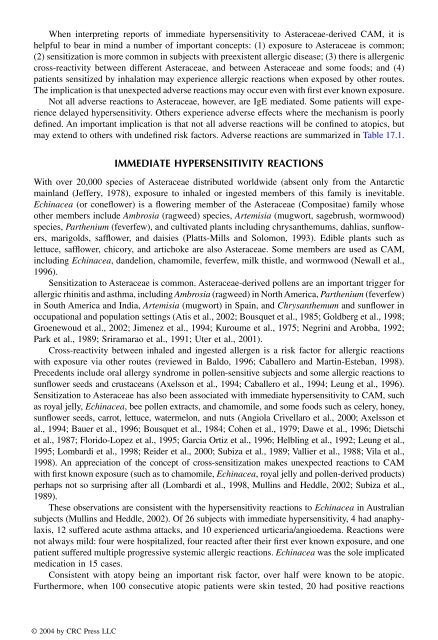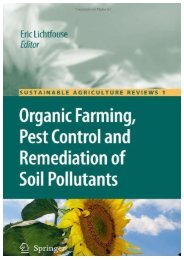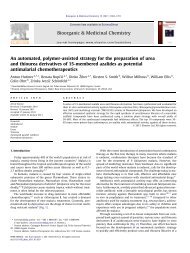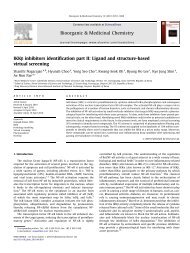Echinacea: The genus Echinacea
Echinacea: The genus Echinacea
Echinacea: The genus Echinacea
Create successful ePaper yourself
Turn your PDF publications into a flip-book with our unique Google optimized e-Paper software.
234 <strong>Echinacea</strong>: <strong>The</strong> <strong>genus</strong> <strong>Echinacea</strong><br />
When interpreting reports of immediate hypersensitivity to Asteraceae-derived CAM, it is<br />
helpful to bear in mind a number of important concepts: (1) exposure to Asteraceae is common;<br />
(2) sensitization is more common in subjects with preexistent allergic disease; (3) there is allergenic<br />
cross-reactivity between different Asteraceae, and between Asteraceae and some foods; and (4)<br />
patients sensitized by inhalation may experience allergic reactions when exposed by other routes.<br />
<strong>The</strong> implication is that unexpected adverse reactions may occur even with first ever known exposure.<br />
Not all adverse reactions to Asteraceae, however, are IgE mediated. Some patients will experience<br />
delayed hypersensitivity. Others experience adverse effects where the mechanism is poorly<br />
defined. An important implication is that not all adverse reactions will be confined to atopics, but<br />
may extend to others with undefined risk factors. Adverse reactions are summarized in Table 17.1.<br />
IMMEDIATE HYPERSENSITIVITY REACTIONS<br />
With over 20,000 species of Asteraceae distributed worldwide (absent only from the Antarctic<br />
mainland (Jeffery, 1978), exposure to inhaled or ingested members of this family is inevitable.<br />
<strong>Echinacea</strong> (or coneflower) is a flowering member of the Asteraceae (Compositae) family whose<br />
other members include Ambrosia (ragweed) species, Artemisia (mugwort, sagebrush, wormwood)<br />
species, Parthenium (feverfew), and cultivated plants including chrysanthemums, dahlias, sunflowers,<br />
marigolds, safflower, and daisies (Platts-Mills and Solomon, 1993). Edible plants such as<br />
lettuce, safflower, chicory, and artichoke are also Asteraceae. Some members are used as CAM,<br />
including <strong>Echinacea</strong>, dandelion, chamomile, feverfew, milk thistle, and wormwood (Newall et al.,<br />
1996).<br />
Sensitization to Asteraceae is common. Asteraceae-derived pollens are an important trigger for<br />
allergic rhinitis and asthma, including Ambrosia (ragweed) in North America, Parthenium (feverfew)<br />
in South America and India, Artemisia (mugwort) in Spain, and Chrysanthemum and sunflower in<br />
occupational and population settings (Atis et al., 2002; Bousquet et al., 1985; Goldberg et al., 1998;<br />
Groenewoud et al., 2002; Jimenez et al., 1994; Kuroume et al., 1975; Negrini and Arobba, 1992;<br />
Park et al., 1989; Sriramarao et al., 1991; Uter et al., 2001).<br />
Cross-reactivity between inhaled and ingested allergen is a risk factor for allergic reactions<br />
with exposure via other routes (reviewed in Baldo, 1996; Caballero and Martin-Esteban, 1998).<br />
Precedents include oral allergy syndrome in pollen-sensitive subjects and some allergic reactions to<br />
sunflower seeds and crustaceans (Axelsson et al., 1994; Caballero et al., 1994; Leung et al., 1996).<br />
Sensitization to Asteraceae has also been associated with immediate hypersensitivity to CAM, such<br />
as royal jelly, <strong>Echinacea</strong>, bee pollen extracts, and chamomile, and some foods such as celery, honey,<br />
sunflower seeds, carrot, lettuce, watermelon, and nuts (Angiola Crivellaro et al., 2000; Axelsson et<br />
al., 1994; Bauer et al., 1996; Bousquet et al., 1984; Cohen et al., 1979; Dawe et al., 1996; Dietschi<br />
et al., 1987; Florido-Lopez et al., 1995; Garcia Ortiz et al., 1996; Helbling et al., 1992; Leung et al.,<br />
1995; Lombardi et al., 1998; Reider et al., 2000; Subiza et al., 1989; Vallier et al., 1988; Vila et al.,<br />
1998). An appreciation of the concept of cross-sensitization makes unexpected reactions to CAM<br />
with first known exposure (such as to chamomile, <strong>Echinacea</strong>, royal jelly and pollen-derived products)<br />
perhaps not so surprising after all (Lombardi et al., 1998, Mullins and Heddle, 2002; Subiza et al.,<br />
1989).<br />
<strong>The</strong>se observations are consistent with the hypersensitivity reactions to <strong>Echinacea</strong> in Australian<br />
subjects (Mullins and Heddle, 2002). Of 26 subjects with immediate hypersensitivity, 4 had anaphylaxis,<br />
12 suffered acute asthma attacks, and 10 experienced urticaria/angioedema. Reactions were<br />
not always mild: four were hospitalized, four reacted after their first ever known exposure, and one<br />
patient suffered multiple progressive systemic allergic reactions. <strong>Echinacea</strong> was the sole implicated<br />
medication in 15 cases.<br />
Consistent with atopy being an important risk factor, over half were known to be atopic.<br />
Furthermore, when 100 consecutive atopic patients were skin tested, 20 had positive reactions<br />
© 2004 by CRC Press LLC









